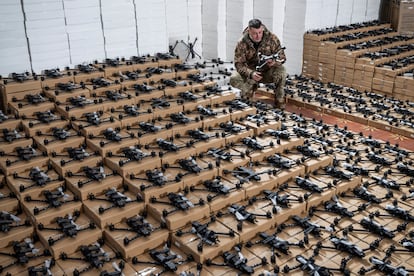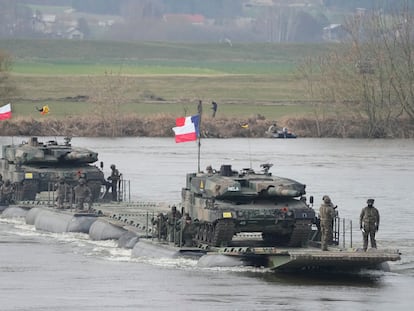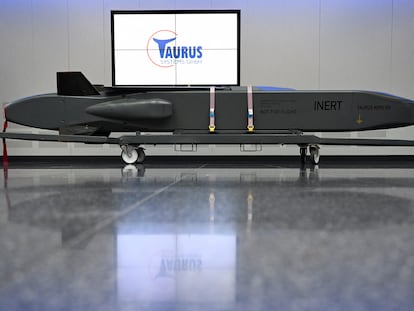Ukraine launches offensive against the Russian oil industry
Swarms of long-range drone bombs have damaged a dozen fuel refinery plants deep inside enemy territory, causing a disruption of up to 15% in Russia’s production of crude oil fuels

The Ukrainian army has achieved a new feat far from the trenches of the front lines. Its long-range drone bombs successfully attacked at least seven oil refineries in Russia last week, although Russian military blogging accounts place the number at nine. The Ukrainian Interior Ministry says there have been 12 such attacks so far this year. The authorities in Kyiv and energy analysis centers estimate a disruption of up to 15% in Russia’s production of crude oil fuels. This offensive represents an evolution in the use of long-range unmanned weapons and in the strategy of taking the war to the invader’s territory.
Ukraine has regularly struck targets hundreds of miles into Russian territory since the summer of 2023: military airfields, factories, sabotage attacks on the railway network and drones have even reached Moscow. But these more recent strikes represent a qualitative leap that is surprising both Ukrainian and Russian defense analysts. A key part of the puzzle, Ukrainian military analysis outlet Defense Express noted on March 16, is how Ukrainian forces are overcoming the electromagnetic wave jammers that disconnect unmanned vehicles’ communications with their pilots with such apparent ease. Defense Express claims that along the Russian border with Ukraine, there is a barrier of electromagnetic wave systems 10 kilometers (6.2 miles) in diameter.
The U.S.-based Institute for the Study of War, a leading reference point in the analysis of the conflict in Ukraine, last week collected widespread criticism from Russian military accounts that also questioned how it was possible that the electromagnetic defenses installed in the refineries, as well as anti-aircraft defenses and helicopters, failed to shoot down drones that in some cases penetrated 1,000 kilometers (620 miles) into Russian airspace. This was the case on March 16 with the successful attack on two plants in the Samara region. In the specific case of the Novokuibyshevsk refinery, a video posted on social networks showed images of the distillation tower, a fundamental element in obtaining fuel from crude oil, in flames. The plant becomes inoperative if the tower is damaged.
The Tuapse plant, bombed on January 25 with drones launched from unoccupied Ukraine 600 kilometers (370 miles) away, remains inoperative, the Russian daily Kommersant reported. Bloomberg stated that there are 31 crude oil refineries in Russia, mostly in the west of the country. The Russian army has allocated a large part of its anti-aircraft defense systems to the eastern front in Ukraine, as these are key to its air dominance and ensuring it retains the initiative.

Target: the distillation tower
Defense Express notes the high precision of Ukrainian attacks that are capable of targeting distillation towers. Another example occurred on March 13, when drones destroyed a refinery tower in Ryazan, 450 kilometers (280 miles) from Ukraine. Liuti (“fury,” in Ukrainian) drones — which can carry 75 kilograms of explosives and have a range of up to 1,000 kilometers — were used in that attack. Liuti have been identified in other operations this year, as well as the confirmed use of UJ-26 Beavers and old Soviet TU-141 reconnaissance drones adapted to serve as assault projectiles.
The number of vehicles making up the drone swarms used in the attacks is unknown, but the Russian military analysis group Rybar stated that 17 drones were involved in the shelling of the Slaviansk refinery in the early hours of March 17, of which 15 were shot down.
The Ukrainian SSU and GUR security and intelligence services have acknowledged being behind major operations against the Russian energy sector. Both the SSU and the GUR have also demonstrated their effectiveness in attacking Russian naval vessels in the Black Sea with groups of nautical drone bombs. The vehicles are deployed with high levels of coordination, seeking first to disable the ship’s rudder so that it cannot maneuver; they then target the hull, at a point where they know ammunition is stored. Once the first fracture is achieved, the rest of the drones aim at the same damaged point to widen the gap and ensure the sinking of the vessel.
Artificial intelligence
The campaign against Russian refineries coincides with the Ukrainian government and its NATO allies’ bid to incorporate artificial intelligence into combat drones. The aim is to make up for the artillery deficit on the front line, but also the lack of long-range missiles for offensives such as the one that is putting a strain on the Russian energy sector.
Alexander Kamyshin, Minister of Strategic Industries, told EL PAÍS on March 15 that 2024 would be “the year of artificial intelligence and its use in proximity [drone] swarms.” The Ukrainian and Russian militaries claim that they are using artificial intelligence in drone bombs on the front lines, in an initial phase. The AI allows the vehicle to operate and make decisions autonomously if the pilot loses control. Once the target is programmed, if communication with the drone fails, based on the images it takes with its camera the vehicle could continue to navigate until it identifies its target.
The United Kingdom and Latvia have taken the lead in a NATO plan to supply one million drones to Ukraine in coalition with other countries. The parties involved have stressed that these devices will be fitted with AI systems. NATO sources told Bloomberg that the drones will be able to coordinate with each other, including those that have lost connection with their pilots.
Both Kamyshin and Ukrainian Innovation Minister Mykhailo Fedorov have stated since February that the priority is to incorporate AI into drone fleets, both those used on the front lines and long-range drones. No official source has indicated that the attacks against Russian refineries have involved AI. Experts stress that full autonomy of unmanned vehicles is still at an embryonic stage, but Olga Husieva, a defense analyst at Kiel University’s Institute for Security Policy, explained to this newspaper last week that AI is already a priority area of collaboration between Ukraine and NATO.
Sign up for our weekly newsletter to get more English-language news coverage from EL PAÍS USA Edition
Tu suscripción se está usando en otro dispositivo
¿Quieres añadir otro usuario a tu suscripción?
Si continúas leyendo en este dispositivo, no se podrá leer en el otro.
FlechaTu suscripción se está usando en otro dispositivo y solo puedes acceder a EL PAÍS desde un dispositivo a la vez.
Si quieres compartir tu cuenta, cambia tu suscripción a la modalidad Premium, así podrás añadir otro usuario. Cada uno accederá con su propia cuenta de email, lo que os permitirá personalizar vuestra experiencia en EL PAÍS.
¿Tienes una suscripción de empresa? Accede aquí para contratar más cuentas.
En el caso de no saber quién está usando tu cuenta, te recomendamos cambiar tu contraseña aquí.
Si decides continuar compartiendo tu cuenta, este mensaje se mostrará en tu dispositivo y en el de la otra persona que está usando tu cuenta de forma indefinida, afectando a tu experiencia de lectura. Puedes consultar aquí los términos y condiciones de la suscripción digital.
More information
Archived In
Últimas noticias
Most viewed
- Alain Aspect, Nobel laureate in physics: ‘Einstein was so smart that he would have had to recognize quantum entanglement’
- Mexico’s missing people crisis casts a shadow over World Cup venue
- Why oil has been at the center of Venezuela-US conflicts for decades
- Trump clarifies who is ultimately in charge in Venezuela: ‘Me’
- Mexico seeks to shore up its defenses following US incursion in Venezuela











































